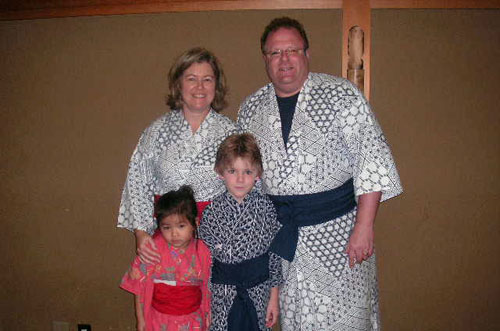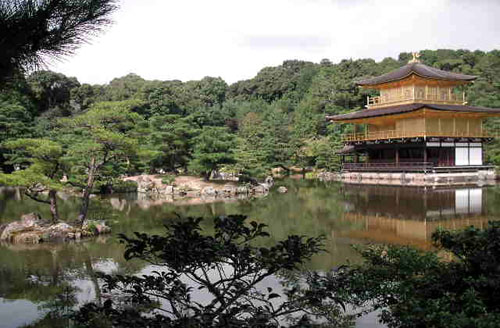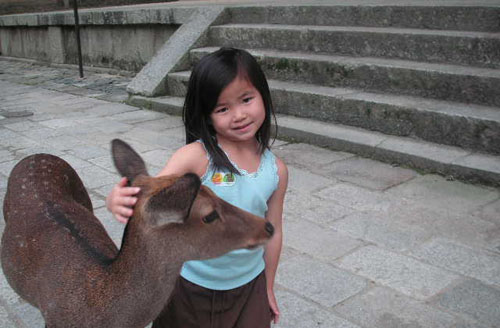
Our Trip
In October of 2007, we started off our trip to Japan in Tokyo and spent the second half in Kyoto. From Tokyo to Kyoto there are several ways to get there, but the most exciting way for a first-time visitor to Japan is to take the bullet train. As you zip through the countryside and towns during two-hour plus trip, it is an amazing smooth ride. It would have been a comfortable ride too had we had seats!
When we purchased our tickets at the train station the agent said we could purchase reserved seats or go into coach class for a lower charge. Based on the time of day we were taking the train to Kyoto, we were told that there were plenty of open seats available so we decided to save the money and go coach. Huge mistake! The bullet trains in Japan – at least this one – are long with many cars. We took the JR Tokaido Shinkansen bullet train, a 140 Min. ride and managed to enter the station at the front end of the platform where the reserved sections are located. The open-seating coach sections were at the other end. Since we were running late and had to board immediately, we rolled our three huge suitcases through at least 15 cars (most of them smoke-filled death chambers) through the front (reserved section) and to the coach class only to find all the seats were taken. Our only choice was to hang out for the balance of our trip in the restroom area between the seating sections of two cars. It was a long 2 hours.
Once we arrived in Kyoto we took a taxi to our “hotel”. Our travel agent (Jennifer) had booked a room (1) at a traditional Japanese hotel and bath house called Kyoto Garden Ryokan Yachiyo. We were going to sleep on the floor on Tatami mats! The hotel also had a huge public Japanese Bath that we could have used but it was public and had way too many rules and customs associated with it, so we passed on that adventure!
Anyway, all lined up in a row on the floor were four pads about two inches thick with a fitted sheet and blanket. In the closet were traditional Japanese robes called Yukatas, and slippers. No TV for the kids, no lounge chair for Big Daddy – just a coffee table that sat in the middle of the floor that would be moved aside for the mats. Following our welcome pot of tea we checked out all the hotel had to offer then headed out for dinner.
Fun Facts & Tips

The population of Kyoto is 1.4 million. It used to be the capital of Japan until 1869 when the Imperial Restoration moved it to Toyko. Because Kyoto was spared much of the bombings from WWII it is the best preserved city in Japan. It is rich with history and many old buildings and Buddhist temples that existed before WWII.
Kyoto is a wonderful place to learn about Japanese history and actually visit the homes of the Emperors that ruled Japan for many centuries.
If you visit Kyoto, I strongly recommend staying in a Ryokan, it was a huge adventure for all of us and one Sean and Sophie still talk about.
Places we visited:
Nijo Castle – This castle, built in 1603 and completed in 1626 as a residence for the first Tokugawa Shoguns, rulers of Japan, and is famous for it’s “Nightingale floors” built as a security measure to alert the Shoguns of any intruders. This is a beautiful palace with lots to see inside and amazing gardens outside.
Golden Pavilion - A Zen temple, dates back to 1301 but was burnt down in 1950 by a monk and later re-built in 1955. The pavilion houses sacred relics of Buddha and is covered in Gold Leaf. The garden here is amazing as it is the original garden and can be enjoyed as it was hundreds of years ago.
Imperial Palace - Was built in the year of 1331 to house Japan’s Imperial Family and remained the residence until 1869 when the capital was moved to Tokyo. The palace has been burned down a lot in it’s history and re-built very quickly. The Japanese architecture is fantastic here.
Todaiji Temple – This temple houses the Great Buddha in the world’s largest wooden building. Again, an amazing wonder of religious architecture, it’s located in the city of Nara where in 710 was the first permanent capital of Japan. Todaiji Temple was constructed in 752 as the head temple of all provincial Buddhist Temples in Japan. Many of Japan’s oldest Buddhist temples are located here.
Deer Park – Attached to the temple is Deer Park. Here thousands of deer roam freely and are more than happy to eat out of your hands. The deer which have been designated as National Treasures, are said to be the messengers of the Shinto Gods. The Shinto (“the way of the Gods”) faith is very common in Japan and only second to Buddhism.
Welcome to Kyoto, Japan

Sophie looks scared to death but she actually had a really good time!
Kyoto is a beautiful and culturally-rich city full of temples and other ancient artifacts. Our first full day was spent temple-hopping to see and hear about how the ancient Japanese society lived thousands of years ago. It was a tiring, yet amazing day filled with neat facts and lore that really made one take thought on what it must have been like to live in this period of time.
Day two was spent closer to the city exploring the sights and sounds. We also managed to make it to a few galleries and purchased a couple of old artifacts to remember our time in Japan. The big event for day two was the traditional Japanese dinner served at our hotel.
After cleaning up the family adorned our Yukatas and slippers that were provided in our room and headed downstairs to a traditional restaurant where we sat on the floor for our dinner event. In walks an older Japanese woman who was somebody’s grandmother dressed in a traditional Japanese robe, hair swept up and as pristine as one could be. For the next 1.5 hours she was going to help us cook our dinner at the table and try to communicate with us.
After the food arrived – raw meats, vegetables, eggs, rice and other item unknown to many Westerners – it was time to eat… and we were all starving!
First we all crack raw eggs into a bowl. Immediately we’re all thinking fried rice! Not! The raw egg was to dip the meat into then eat. For Westerners raw egg is not considered to be safe eating and we’re all sitting there looking, wondering and starving. Sophie goes first – dips her meat into the raw egg and eats it. After a few oohs and awes we each dive in. You’d had thought that we had to eat live worms or something.
By the time the first bite goes down the vegetables and other meats that were boiling in the pot on the table were ready, so we all begin to focus on everything else but the raw eggs.

The Golden Pavilion

Deer Park
Over the years in Asia we have seen many wonderful historical aspects of the Eastern world – rich in history thousands of years old. The Japanese had been eating raw eggs for thousands of years yet they manage to thrive and survive. The Japanese and other Asians are thin and healthy – unlike Americans. This really makes one think about what we eat throughout our lives.
Additional Photos.